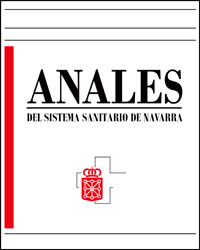Attitudes, self-efficacy and intention towards tobacco cessation in Spanish college students
DOI:
https://doi.org/10.23938/ASSN.0588Keywords:
Students. Tobacco use cessation. Self-efficacy. Attitudes. Intention.Abstract
Background. To determine attitudes towards smoking, perception of self-efficacy, and the intention of smoking cessation in college student smokers, and their variation according to the stage of the tobacco cessation process.
Methods. Cross-sectional study with 255 college students (18-24 years old) smokers of ≥1 cigarette per week. Instruments used: a personal interview, Fageström test, trans-theoretical change model, scale of Attitudes, self-efficacy and intention to quit smoking in college smokers and CO in exhaled air.
Results. Sample with a majority of women (62%), average age 20.3 years, users of 9.2 cigarettes/day for 5.7 years, with mild dependence on nicotine; 69% were in the stages of pre-contemplation and contemplation. Although smoking was considered to be negative for health and the environment for more than 70%, and 96.7% had negative attitudes towards tobacco, only 45.1% were aware of the associated morbidity and mortality. More than 60% considered tobacco to be a social facilitator, thus anxiety (72.6%) and having friends who smoke (69.4%) are factors considered negative for tobacco cessation. Ninety-one percent believed that they would smoke next year, but 86% stated that they would not be a smoker within five years. One hundred percent of the subjects in pre-contemplation considered that they will smoke during the next year as opposed to 83.5% of those in the stage of preparation.
Conclusion. College student smokers show positive attitudes, erroneous beliefs and a low perception of self-efficacy about smoking cessation. All students in the pre-contemplation phase do not even consider smoking cessation in the medium and long term.
Downloads
References
US Department of Health and Human Services. The Health Consequences of Smoking - 50 Years of Progress: A Report of the Surgeon General. Atlanta: GA: US Department of Health and Human Services, Centers for Disease Control and Prevention, National Center for Chronic Disease Prevention and Health Promotion, Office on Smoking and Health; 2014. https://www.surgeongeneral.gov/library/reports/50-years-of-progress/full-report.pdf
PARDAVILA-BELIO MI, GARCÍA-VIVAR C, PIMENTA AM, CANGA-ARMAYOR A, PUEYO-GARRIGUES S, CANGA-ARMAYOR N. Intervention study for smoking cessation in Spanish college students: pragmatic randomized controlled trial. Addiction 2015; 110:1676-1683. https://doi.org/10.1111/add.13009
US Department of Health and Human Services. Preventing tobacco use among youth and young adults: A report of the surgeon general. Atlanta: US Department of Health and Human Services, Centers for Disease Control and Prevention, National Center for Chronic Disease Prevention and Health Promotion, Office on Smoking and Health 2012. https://www.surgeongeneral.gov/library/reports/preventing-youth-tobacco-use/index.html#Full Report
Observatorio español de la droga y las adicciones. Informe 2017. Alcohol, tabaco y drogas ilegales en España. 2017. http://www.pnsd.msssi.gob.es/profesionales/sistemasInformacion/informesEstadisticas/pdf/2017OEDA-INFORME.pdf. Consultado el 15 de mayo de 2018.
MUÑOZ-MUÑOZ E. Prevalencia, actitud, conocimiento del tabaco y terapias de deshabituación en estudiantes de Farmacia en España. Tesis doctoral. Universidad de Granada, 2013.
BERNAT DH, KLEIN EG, FORSTER JL. Smoking initiation during adulthood: a longitudinal study of population-based cohort. J Adolesc Health 2012; 51: 497-502. https://doi.org/10.1016/j.jadohealth.2012.02.017
FLAY BR. Youth tobacco use: risk, patterns, and control. En Orleans, C. T., & Slade, J. Nicotine Addiction: Principles and Management. New York: Oxford University Press 1993; 365-384.
Centers for disease control and prevention. Best Practices for Comprehensive Tobacco Control Programs-2014. Atlanta: U.S. Department of Health and Human Services, Centers for Disease Control and Prevention, National Center for Chronic Disease Prevention and Health Promotion, Office on Smoking and Health 2014. https://www.cdc.gov/tobacco/stateandcommunity/best_practices/pdfs/2014/comprehensive.pdf
ALEGRE M, GUTIÉRREZ A, OLIVÁN V, VARA E, MARTÍNEZ-GONZÁLEZ MA, AGUINAGA I y col. Prevalencia del tabaquismo, conocimiento y valoración de los métodos de cesación tabáquica en estudiantes de medicina. An Sist Sanit Navar 1999; 22: 233-240. https://doi.org/10.23938/ASSN.0499.
PARDAVILA-BELIO MI, CANGA-ARMAYOR A, DUASO MJ, PUEYO-GARRIGUES S, PUEYO-GARRIGUES M, CANGA-ARMAYOR N. Understanding how a smoking cessation intervention changes beliefs, self-efficacy and intention to quit. A secondary analysis of a pragmatic randomized controlled trial. Transl Behav Med 2018. https://doi.org/10.1093/tbm/ibx070
PROCHASKA JO, DICLEMENTE CC. Stages and processes of self- change of smoking: toward an integrative model of change. J Consult Clin Psychol 1983; 51: 390-395. https://doi.org/10.1037/0022-006X.51.3.390
HEATHERSON TF, KOZLOWSKI LT, FRECKER RC, FAGERSTRÖM KL. The Fagerstrom Test for nicotine dependence: a revision of the Fagerström Tolerance Questionnaire. Br J Addict 1991; 86: 1119-1127. https://doi.org/10.1111/j.1360-0443.1991.tb01879.x
Bedfont. Smokerlyzer® Range For use with piCOTM, piCObabyTM and Micro+TM User manual. 2017. https://www.bedfont.com/file/2494-LAB679%20Smokerlyzer%20Manual%20Issue%203.pdf. Consultado 26 de febrero de 2018
FORD KH, DIAMOND PM, KELDER SH, STERLING KL, MCALISTER AL. Validation of scales measuring attitudes, self-efficacy, and intention related to smoking among middle school students. Psychol Addict Behav 2009; 23: 271-278. https://doi.org/10.1037/a0013747
NORIEGA-GARCÍA C, MARTÍN-SANZ N. Psicología social. En: Losada-Delgado ML, editor. Fundamentos de Psicología para Ciencias Sociales y de la Salud. Madrid: Editorial Médica Panamericana, 2014; 295-315.
HOEPPNER BB, BIDWELL LC, COLBY SM, BARNETT NP. Smoking patterns and their relationship to drinking among first-year College students. Nicotine Tob Res 2014; 16: 743-752. https://doi.org/10.1093/ntr/ntt205
ZUZULICH MS. ¿El paso por la Universidad afecta al consumo de tabaco? Horizonte de Enfermería 2008; 19; 29-43. https://doi.org/10.7764/Horiz_Enferm.19.1.29
Downloads
Published
How to Cite
Issue
Section
License
Copyright (c) 2019 Anales del Sistema Sanitario de Navarra

This work is licensed under a Creative Commons Attribution-ShareAlike 4.0 International License.
La revista Anales del Sistema Sanitario de Navarra es publicada por el Departamento de Salud del Gobierno de Navarra (España), quien conserva los derechos patrimoniales (copyright ) sobre el artículo publicado y favorece y permite la difusión del mismo bajo licencia Creative Commons Reconocimiento-CompartirIgual 4.0 Internacional (CC BY-SA 4.0). Esta licencia permite copiar, usar, difundir, transmitir y exponer públicamente el artículo, siempre que siempre que se cite la autoría y la publicación inicial en Anales del Sistema Sanitario de Navarra, y se distinga la existencia de esta licencia de uso.








